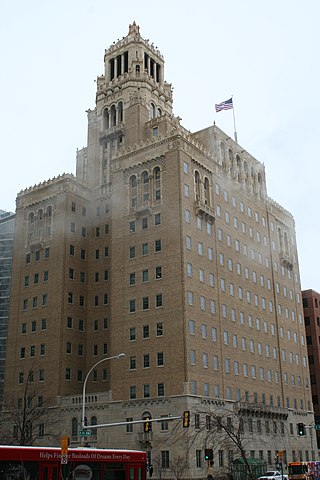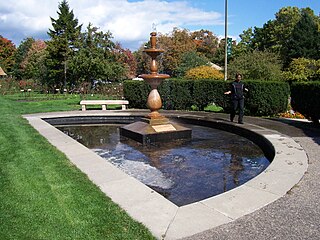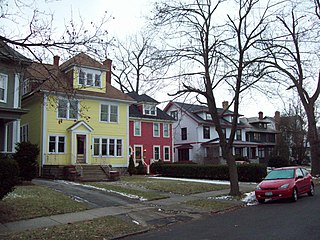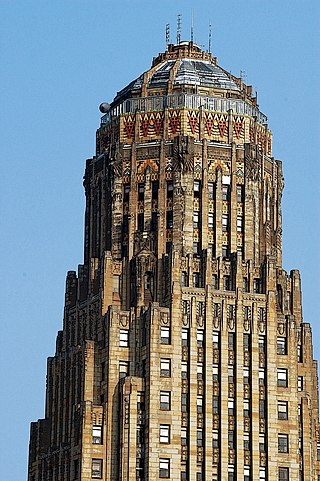
Frederick Law Olmsted was an American landscape architect, journalist, social critic, and public administrator. He is considered to be the father of landscape architecture in the United States. Olmsted was famous for co-designing many well-known urban parks with his partner Calvert Vaux. Olmsted and Vaux's first project was New York's Central Park, which led to many other urban park designs, including Prospect Park in Brooklyn and Cadwalader Park in Trenton, New Jersey. He headed the preeminent landscape architecture and planning consultancy of late 19th century United States, which was carried on and expanded by his sons, Frederick Jr. and John C., under the name Olmsted Brothers.

Caledonia is a town in Livingston County, New York, United States. The population was 4,255 at the 2010 census. The town contains the village of Caledonia. The town is in the northwestern part of the county and is southwest of Rochester. It is part of the Rochester metropolitan area.

Niagara Falls State Park is located in the City of Niagara Falls in Niagara County, New York, United States. The park, recognized as the oldest state park in the United States, contains the American Falls, the Bridal Veil Falls, and a portion of the Horseshoe Falls.

Seneca Park Zoo is a 20-acre zoo located in the city of Rochester, New York, US. The zoo is home to over 90 species including mammals, reptiles, birds, amphibians, fish, and arachnids. It is accredited by the Association of Zoos and Aquariums (AZA). The zoo is operated by Monroe County, with support from the Seneca Park Zoo Society. The zoo opened in 1894 in Seneca Park.

The Olmsted Brothers company was a landscape architectural firm in the United States, established in 1898 by brothers John Charles Olmsted (1852–1920) and Frederick Law Olmsted Jr. (1870–1957), sons of the landscape architect Frederick Law Olmsted.

Frederick Law Olmsted National Historic Site is a United States National Historic Site located in Brookline, Massachusetts, a suburb of Boston. Frederick Law Olmsted (1822–1903) is recognized as the founder of American landscape architecture and the nation's foremost parkmaker of the 19th century. In 1883, Olmsted moved his home to suburban Boston and established "Fairsted", the world's first full-scale professional office for the practice of landscape design. Over the course of the next century, his sons and successors expanded and perpetuated Olmsted's design ideals, philosophy, and influence.

The Plummer Building in Rochester, Minnesota, is one of the many architecturally significant buildings on the Mayo Clinic campus. This new "Mayo Clinic" building, opened in 1928, added much needed space to the ever-expanding Mayo practice. The architect of record is Ellerbe & Co, now AECOM. It was the third building designed by the firm for the Mayo Clinic. The Mayo Clinic Buildings were listed on the U.S. National Register of Historic Places in 1969, and the Plummer Building was further designated as U.S. National Historic Landmark a week later, designated as Mayo Clinic Building.

List of Registered Historic Places in Seneca County, New York

The Veterans Memorial Bridge in Rochester, New York, carries New York State Route 104 across the Genesee River. The bridge is an architecturally significant concrete arch faced with white granite. Conceived in 1928 and finished in 1931, the span is the longest bridge in Rochester at 981 feet (299 m). It is 190 feet (58 m) in height and 106 feet (32 m) wide.

Genesee Valley Park, originally named "South Park", is located in the south side of Rochester, New York along the shores of the Genesee River. The New York State Barge Canal crosses the Genesee River within the park. The University of Rochester is located near the park's north entrance.

Maplewood Park, also known as Seneca Park West, is a landscaped public park in Rochester, New York, situated between Lake Avenue and the Genesee River. The two-mile-long (3.2 km) park features many trails along the river gorge and the river bank below, scenic views of two waterfalls and a nationally accredited Rose Garden.

The Southtowns is a region of Western New York, United States, that lies within the snowbelt or ski country. It includes the southern suburbs of Buffalo, New York. This is the common name for the southern part of Erie County, New York.

This is a list of the National Register of Historic Places listings in Olmsted County, Minnesota. It is intended to be a complete list of the properties and districts on the National Register of Historic Places in Olmsted County, Minnesota, United States. The locations of National Register properties and districts for which the latitude and longitude coordinates are included below, may be seen in an online map.

Parkside East Historic District is a national historic district located at Buffalo in Erie County, New York. The district is architecturally and historically significant for its association with the 1876 Parks and Parkways Plan for the city of Buffalo developed by Frederick Law Olmsted. It consists of 1,769 contributing structures developed from 1876 to 1936, as a middle class residential neighborhood. The district largely contains single-family dwellings, built in a variety of popular architectural styles, and located along the irregular and curvilinear street pattern developed by Olmsted. The district is located to the east of Buffalo's Delaware Park and includes the Walter V. Davidson House and the separately listed Darwin D. Martin House, both designed by Frank Lloyd Wright.

Martin Luther King Jr. Park, originally The Parade and after 1896, Humboldt Park, is a historic park located in Buffalo in Erie County, New York. The park is located in east Buffalo and bisected by Fillmore Avenue.
Cazenovia Park–South Park System is a historic park system located in the South Buffalo neighborhood at Buffalo in Erie County, New York. The interconnected set of parkways and parks was designed by Frederick Law Olmsted as part of his parks plan for the city of Buffalo, as inspired in large part by the parkland, boulevards, and squares of Paris, France.
The Maplewood Historic District is located in Rochester in Monroe County, New York. The district is distinguished as having landscape designs, including Maplewood Park, originally laid out by Frederick Law Olmsted.

City Hall Historic District is a national historic district located at Rochester in Monroe County, New York. The district consists of four buildings arranged in a 19th-century civic complex. The buildings are the Rochester City Hall (1874–1875), Monroe County Courthouse (1894–1896), Rochester Free Academy (1872–1873), and St. Luke's Episcopal Church (1824). Andrew Jackson Warner designed the City Hall and Free Academy buildings. His son, J. Foster Warner, designed the Monroe County Courthouse.

The Architecture of Buffalo, New York, particularly the buildings constructed between the American Civil War and the Great Depression, is said to have created a new, distinctly American form of architecture and to have influenced design throughout the world.
















